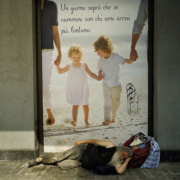Group Clinical Experiences in Psychiatric Institutional Settings
In this article, several young colleagues, who have been trained in individual and group psychoanalytic contexts, who have all been asked to support activities in the field of highly skilled psychiatry (group psychotherapy) with a “low cost” and implicitly unsafe contract, have tried to outline some features of their experiences of managing groups in psychiatric institutions. Their position is situated on one hand, in a line of continuous progress from their trainers, and on the other appears in a complex and difficult gap between the philosophy of staff working today (eg Evidence-Based Medicine) and psychoanalytic psychotherapy training, which provides radically different concepts, like, for example, the “dreamability” of care processes.
The pathway proposed in this work sees different group psychotherapy experiences, usually with acute patients, often in a separate psychotherapy area in treatment units (the social value of their work and the frequent poverty, which is not only economic, of the institutions should be noted).
Although these contributions may perhaps be a little fragmented (these individual “snapshots” of complex group experiences are minimized in a textual sense, in addition to differences in personal styles), it must be said they do capture the border problems between groups and psychiatry in different contexts, namely in SPDC (Viganoni), in the Community (Castelli), in private practice (Gubetti), in local services (Grasso), in dual diagnosis communities (Catullus and Tagliabue) and in former psychiatric hospitals (Della Cerra). The sequence of interventions is designed starting with the possible pathways for the patient-types who may travel through some or all these experiences.
The difficulties they have encountered therefore, as well as being “routine” clinically, are also institutional, in a way that often leaves the handler in a “solitary commander” position, caught between the clinical needs that a group space helps bring out, and the marginality of their role (trainees, in the main) or the greater institutional investment in operativecognitive projects.
In this sense, the way institutional analytical activities are structured cannot be separated from clinical work strictly speaking, but rather, constitutes an item of interest for the mental organization of institutional units, and for the reciprocal benefit between group psychotherapy and psychiatry.
One element that led me to favour the opinions of colleagues in institutions is also their habit of writing down and communicating notes about clinical sessions, and therefore of providing an element of truth, along with willingness to discuss what they do with groups.
This does not obviously lower respect for patients, which is a tendency in some trainers, or loss of the views of the patients themselves, but a tendency to untie theories from their clinical involvement, which is a departure from what has been done by experts in every era. The colleagues who have contributed to this work present their own personal viewpoints about their job and institutions, and from the start, present themes concerning their own personal therapeutic desires, and their own relationships with the mental health units in which they are situated. In their work, one can observe several similarities with the concepts of freedom of emotional expression, individual or group, of a willingness towards self- disclosure, and at all levels their own personal aims are brought into play in order to act as representatives of the suffering minds who need them.
Viganoni has the courage to ponder and dream (the task of alpha sleep) about the thoughts of patients in the acute or post-acute phase, underlining the importance of dreams for the representative activities with seriously ill patients.
Grasso opens with the institutional difficulties, the diversity of job codes for routine welfare and recreational activities, the need for integration with group psychoanalysis, and ends with the main changes in the group atmosphere and workplace related stress for the therapist.
Castelli’s section is also about the need to weld what was has been done previously and his own work experience, in which he found himself having to rethink, seek out and reflect on the available dream tools of his own mind, and ways of working that gave him an inner freedom parallel to that of his patients.
Gubetti expresses his sense of the strength of the therapeutic model, with a great opportunity for emotionally orientating and grouping severe patients, who are often left to deal with parenting failures or mental catastrophes by a care system that deliberately ignores the psychological dimension.
Catullo and Tagliabue express their views about extremely acute and serious conditions (the so-called resistant patients), characterized by a “quick-fire” toxico-maniacal defence about their severe mental illness: the sudden abandonment and separation of many of these patients emerges as a very significant element that forces the groups to acknowledge isolation, and particularly loss, as an essential element of mental life.


